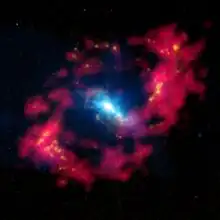| NGC 4151 | |
|---|---|
 Image of NGC 4151 from the 0.8m Schulman Telescope at the Mount Lemmon SkyCenter | |
| Observation data (J2000 epoch) | |
| Constellation | Canes Venatici |
| Right ascension | 12h 10m 32.6s[1] |
| Declination | +39° 24′ 21″[1] |
| Redshift | 0.003262[2] 995 ± 3 km/s[1] |
| Distance | 15.8 ± 0.4 Mpc (51.5×106 ± 1.3×106 ly)[3] |
| Apparent magnitude (V) | 11.5[1] |
| Characteristics | |
| Type | (R')SAB(rs)ab,[1] Sy1[2] |
| Apparent size (V) | 6.4′ × 5.5′[1] |
| Other designations | |
| UGC 7166,[1] PGC 38739[1] | |
NGC 4151 is an intermediate spiral Seyfert galaxy with weak inner ring structure located 15.8 megaparsecs (52 million light-years) from Earth[4] in the constellation Canes Venatici. The galaxy was first mentioned by William Herschel on March 17, 1787; it was one of the six Seyfert galaxies described in the paper [5] which defined the term. It is one of the nearest galaxies to Earth to contain an actively growing supermassive black hole.[6] The black hole would have a mass on the order of 2.5 million to 30 million solar masses.[7] It was speculated that the nucleus may host a binary black hole, with about 40 million and about 10 million solar masses respectively, orbiting with a 15.8-year period.[8] This is, however, still a matter of active debate.
Some astronomers nickname it the "Eye of Sauron" from its appearance.[9]
One supernova has been observed in NGC 4151: SN 2018aoq (Type II, mag 14.4).[10]
X-ray source


.jpg.webp)
X-ray emission from NGC 4151 was apparently first detected on December 24, 1970, with the X-ray observatory satellite Uhuru,[11] although the observation spanned an error-box of 0.56 square degrees and there is some controversy as to whether UHURU might not have detected the BL Lac object 1E 1207.9 +3945, which is inside their error box - the later HEAO 1 detected an X-ray source of NGC 4151 at 1H 1210+393,[12] coincident with the optical position of the nucleus and outside the error box of Uhuru.[11]
To explain the X-ray emission two different possibilities have been proposed:[13]
- radiation of material falling onto the central black hole (which was growing much more quickly about 25,000 years ago) was so bright that it stripped electrons away from the atoms in the gas in its path, and then electrons recombined with these ionized atoms
- the energy released by material flowing into the black hole in an accretion disk created a vigorous outflow of gas from the surface of the disk, which directly heated gas in its path to X-ray emitting temperatures
See also
References
- 1 2 3 4 5 6 7 8 "Results for NGC 4151". NASA/IPAC Extragalactic Database. Retrieved 2007-03-27.
- 1 2 "NGC 4151". SIMBAD. Centre de données astronomiques de Strasbourg. Retrieved 2014-06-06.
- ↑ Yuan, W.; Fausnaugh, M. M.; Hoffmann, S. L.; Macri, L. M.; Peterson, B. M.; Riess, A. G.; Bentz, M. C.; Brown, J. S.; Bontà, E. Dalla; Davies, R. I.; Rosa, G. De; Ferrarese, L.; Grier, C. J.; Hicks, E. K. S.; Onken, C. A.; Pogge, R. W.; Storchi-Bergmann, T.; Vestergaard, M. (2020). "The Cepheid Distance to the Seyfert 1 Galaxy NGC 4151". The Astrophysical Journal. 902 (1): 26. arXiv:2007.07888. Bibcode:2020ApJ...902...26Y. doi:10.3847/1538-4357/abb377. S2CID 220546047.
- ↑ W. M. Keck Observatory (2014-11-26). "'Eye of Sauron' Provides New Way of Measuring Distances to Galaxies". W. M. Keck Observatory. Archived from the original on 2014-12-05. Retrieved 2014-11-27.
- ↑ C. K. Seyfert (1943). "Nuclear Emission in Spiral Nebulae". Astrophysical Journal. 97: 28–40. Bibcode:1943ApJ....97...28S. doi:10.1086/144488.
- ↑ "NGC 4151: An active black hole in the "Eye of Sauron"". Astronomy magazine. 2011-03-11. Archived from the original on 2019-03-29. Retrieved 2011-03-14.
- ↑ Roberts, Caroline A.; Bentz, Misty C.; Vasiliev, Eugene; Valluri, Monica; Onken, Christopher A. (2021). "The Black Hole Mass of NGC 4151 from Stellar Dynamical Modeling". The Astrophysical Journal. 916 (1): 25. arXiv:2106.02758. Bibcode:2021ApJ...916...25R. doi:10.3847/1538-4357/ac05b6. S2CID 235358825.
- ↑ Bon; Jovanović; Marziani; Shapovalova; et al. (2012). "The First Spectroscopically Resolved Sub-parsec Orbit of a Supermassive Binary Black Hole". The Astrophysical Journal. 759 (2): 118–125. arXiv:1209.4524. Bibcode:2012ApJ...759..118B. doi:10.1088/0004-637X/759/2/118. S2CID 119257514.
- ↑ Chandra X-ray Observatory (10 March 2011). "NGC 4151: An Active Black Hole in the "Eye of Sauron"". Chandra X-ray Center.
- ↑ Transient Name Server entry for SN 2018aoq. Retrieved 5 January 2023.
- 1 2 Gursky H; Kellogg EM; Leong C; Tananbaum H; et al. (Apr 1971). "Detection of X-Rays from the Seyfert Galaxies NGC 1275 and NGC 4151 by the UHURU Satellite". Astrophys J. 165 (4): L43–8. Bibcode:1971ApJ...165L..43G. doi:10.1086/180713.
- ↑ Wood KS; Meekins JF; Yentis DJ; Smathers HW; et al. (December 1984). "The HEAO A-1 X-ray source catalog". Astrophys. J. Suppl. Ser. 56 (12): 507–649. Bibcode:1984ApJS...56..507W. doi:10.1086/190992.
- ↑ Chandra X-Ray Observatory (2011-03-10). "The 'Eye of Sauron'". NASA. Archived from the original on 2011-04-23. Retrieved 2011-03-14.